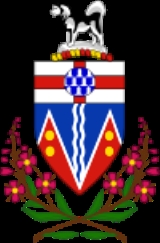
Coat of arms of Yukon
Encyclopedia
The Coat of Arms
of Yukon
was commissioned by the federal Department of Indian Affairs and Northern Development and designed by well-known heraldry expert Alan Beddoe
in the early 1950s. It was approved officially by Queen Elizabeth II
in 1956.
The lower part of the shield represents Yukon's mountains, with the gold disks (called "bezants," a medieval gold coin) representing the territory's mineral resources and its birth in the Klondike Gold Rush
. The two white wavy lines represents the territory's rivers.
In chief, the red cross represents England, the disk surmounting it is in a pattern called "vair," a type of heraldic fur (literally squirrel fur), and representing the territory's wealth of fur-bearing animals.
The crest is an Alaskan Malamute
dog standing on a mound of snow.
Coat of arms
A coat of arms is a unique heraldic design on a shield or escutcheon or on a surcoat or tabard used to cover and protect armour and to identify the wearer. Thus the term is often stated as "coat-armour", because it was anciently displayed on the front of a coat of cloth...
of Yukon
Yukon
Yukon is the westernmost and smallest of Canada's three federal territories. It was named after the Yukon River. The word Yukon means "Great River" in Gwich’in....
was commissioned by the federal Department of Indian Affairs and Northern Development and designed by well-known heraldry expert Alan Beddoe
Alan Beddoe
Lieutenant-Commander Alan Brookman Beddoe, OC, OBE, HFHS, FHSC was a Canadian artist, war artist, consultant in heraldry and founder and first president of the Heraldry Society of Canada in 1965....
in the early 1950s. It was approved officially by Queen Elizabeth II
Elizabeth II of the United Kingdom
Elizabeth II is the constitutional monarch of 16 sovereign states known as the Commonwealth realms: the United Kingdom, Canada, Australia, New Zealand, Jamaica, Barbados, the Bahamas, Grenada, Papua New Guinea, the Solomon Islands, Tuvalu, Saint Lucia, Saint Vincent and the Grenadines, Belize,...
in 1956.
The lower part of the shield represents Yukon's mountains, with the gold disks (called "bezants," a medieval gold coin) representing the territory's mineral resources and its birth in the Klondike Gold Rush
Klondike Gold Rush
The Klondike Gold Rush, also called the Yukon Gold Rush, the Alaska Gold Rush and the Last Great Gold Rush, was an attempt by an estimated 100,000 people to travel to the Klondike region the Yukon in north-western Canada between 1897 and 1899 in the hope of successfully prospecting for gold...
. The two white wavy lines represents the territory's rivers.
In chief, the red cross represents England, the disk surmounting it is in a pattern called "vair," a type of heraldic fur (literally squirrel fur), and representing the territory's wealth of fur-bearing animals.
The crest is an Alaskan Malamute
Alaskan Malamute
The Alaskan Malamute is a generally large breed of domestic dog originally bred for use as a utilitarian dog and later an Alaskan sled dog. They are sometimes mistaken for a Siberian Husky, but in fact are quite different in many ways...
dog standing on a mound of snow.

